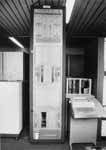Subscription Option - D-bit modification
D-bit normally has the following meaning:
| D-bit (GFI bit 7) | meaning |
| 0 | local significance |
| 1 | end-to-end significance |
In order to support existing equipment, a D-bit modification facility is defined.
When subscribed to, it will do the following:
change from 0 to 1 the value of bit 7 of the GFI in all call request and call accepted packets and the value of the D bit in all DTE data packets received from the DTE.
will set to 0 the value of bit 7 of the GFI in all incoming call and call
connected packets, and the value of the D-bit in all DCE data packets transmitted
to the DTE.
UK does not support D-bit modification.
| X.2 LEVEL 3 PER USER SUBSCRIPTION | X.2 (1984) | UK(a) | UK(b) | interworking | ||
| OPTIONS | REF CLASS | now | now | R5a | R5b | R6 |
| D-bit modification | 1.26 A | T | . | . | . | . |
UK(a) uses D-bit=0 and end-to-end significance.
UK(b) uses D-bit=0 and local significance.
Therefore UK(a) should support D-bit modification, the equipment does support this facility, however it would not be practical for us to implement it, since, the only way that we could do it would be a flash cut-over of the whole network, which is not practical.
&UKa& = y
UKa support
DX1: yes
DX2: yes
TP4/III: ?
D-bit modification is implemented in release 4 (however local significance and proper D-bit operation is not supported by UKa).
Networks such as Public Network were implemented prior to the introduction of the D-bit
procedure (delivery confirmation bit).
At that time bit 7 of the GFI was always coded as 0. Public Network was implemented using
end-to-end significance of the packet level acknowledgements.
table build questions:
TNDTED Q205(was q93 ) d-bit modification (YES/NO)
|TNDTED Q205| q93 | d-bit modification..................#default NO
standard Public Network settings = NO
intended to be used if the DTE does not support D-bit operation
TNDTED Q206(was q94 ) d-bit confirmation (YES/NO)
|TNDTED Q206| q94 | d-bit confirmation..................#default NO
standard Public Network settings = NO
subscription to this allows the DTE to send and receive call setup and data
packets with the D-bit = 1. Intended to be used if the DTE supports D-bit operation
UKa Answers
Question: We currently set D-bit questions (TNDTED53 Q93 and Q94) both to NO.
- Does DTE/STE support D-bit modification ?
- Does DTE/STE support D-bit confirmation ?
If we wish to allow the D-bit to be set on certain lines would we first need to set D-bit modification to YES on the whole network? How would UKa advise us to set these questions ?
Answer : Yes you would need to set all D-bit modification questions to "Yes"
if you wish to use D-bit Confirmation on certain lines.
If this is not done then a call with the D-bit set, from a line that supports D-bit Confirmation, would be cleared by any other line which does not support D-bit confirmation or modification.
Question: Is D-bit transparent to transit switches?
Answer : Yes it is.
&UKb& = yUKb support
v 4.03
SVC: no - future implementation planned
PVC: no - future implementation planned
X.32: no
Turbo Engine:
Mini Engine:
Micro Engine:
Pico Engine:
&telematics& = yTelematics support
not supported
&internal& = y
CCITT compatibility
X.2 1984 ... A - additional service
X.2 1988 ... A - additional service
We do not implement local significance and therefore cannot claim compatibility.
ISO 8878 compatibility
We do not implement local significance and therefore cannot claim compatibility.
ONA compatibility
RD 0004 part 8:1.C (PICS proforma Public Network1984)
DCN - Is D-bit negotiation supported:
DCN1 - for outgoing VCs.... M = Mandatory
DCN2 - for incoming Vcs.... M = Mandatory
RD 0004 part 3:2.C (connection mode service over Public Network 1984)
This has the following text -
"Bit 7 of Octet 1 in the GFI of the X.25/PLP - 1984 call Set-up packets
is used to negotiate the non-use of the receipt confirmation service.
All call request packets sent by the DTE shall have the D-bit set to 0. When
a network layer entity receives an incoming call packet the N-connect indication
primitive signalled to the called NS user shall indicate "No use of receipt
confirmation" irrespective of the setting of the D-bit in the incoming
call packet.
When a network layer entity receives a connect response primitive, the receipt
confirmation selection parameter shall be set to "no use of receipt confirmation",
and consequently Bit 7 of the GFI in the call accepted packet is set to 0. When
an NL entity receives a call connected packet Bit 7 of the GFI will be set to
0 and it shall indicate no use of receipt confirmation to the NS user."
Therefore ONA says that D-bit is always zero, so is compatible with Public Network.
Test plan and implementation issues
During testing we need to check out all combinations of D-bit and D-bit modification at both ends of the call, also all combinations of GFI bit 7 and D-bit.

